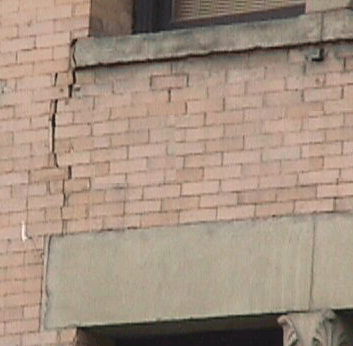 |
masonry crack repair |
| This article was brought to you by- |  |
Specialised products for DIY and Trade |
|---|
CRACKED MASONRY WALLS
THE PROBLEM
Cracks in masonry are the result of movement beyond that which can be accommodated by the construction materials. Buildings tend to crack where masonry is over-stressed and least restrained, such as at window and door openings or at corners. The movement is usually caused by variations in moisture content in the walls, or in the ground that supports them, temperature variations or by chemical reactions. Some movements are cyclic and reversible, many are permanent.

Cracks in brick walls can be divided into three categories:
Unless you know the history of the building, and know that the cracks fall into the passive or cyclic categories, determining the kind a crack can be difficult and will require the input of a structural engineer who will regularly monitor the cracked brickwork over an extended period of time before arriving at a conclusion as to how an active crack can be made passive.
CRACK REPAIR SOLUTION
A cracked masonry wall cannot function as the composite unit for which it was designed until its integrity has been restored and the wall strengthened to at least its pre-cracked state.
 |
Mortar joints are mechanically raked out to form 30-40mm deep slots that extend 500mm either side of the crack in the wall. Slots are located at regular intervals, usually 300mm to 450mm apart |
|---|
 |
Each slot is cleaned out and the bed joint is thoroughly soaked with clean water, making ready to implement the crack-repair |
|---|
 |
A proprietary non-shrink cementitious bonding agent is pumped into the slot filling it from the back of the slot to approximately two thirds deep, along its full length |
|---|
 |
A highly deformed stainless steel crack repair rod is pushed two thirds of the way into the cementitious bonding agent such as to fully embed the rod and tie the masonry on each side of the crack |
|---|
 |
The slots are pointed up to match the existing facade |
|---|
This effective masonry repair technique fully restores the integrity of the cracked wall to its pre-cracked state without costly rebuilding work and with minimum inconvenience to the occupants. The strengthened masonry is able to provide resilience to small and/or cyclic movements and to function as a reinforced non-fractured unit. |
|---|

MASONRY STITCHING PRODUCTS

Profiled and twisted stainless steel helical rods have a nominal ultimate tensile strength that is twice that of rebar, four times that of epoxy glass-fibre rods and seven times that of flat twisted plate [ref: BRE GBG 62].
|
|---|
For free assistance in matters relating to masonry crack repairs in domestic housing phone the Twistfix technical help and advice line on 0845 123 6006 or visit www.twistfix.co.uk
Further Reading: BRE GBG 62: 2004
| BRICKWORK |
|---|